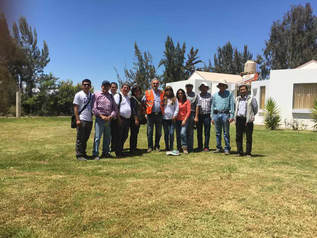A Definite Must Read for Any Black Soldier Fly Enthusiasts - Discussion of Larval Taxonomy10/31/2017 Good news.... bad news... or is it bad news first? I think I will start with the bad news- I am not sure you can locate this paper; however, the good news.... this study was the first life-history study of the BSF. In fact, I believe this paper might be the ONLY one to examine and describe the different larval stages and provide physical features that allow you to distinguish them. May, B. M. 1961. The occurrence in New Zealand and the life-history of the soldier fly Hermetia illucens (L.) (Diptera: Stratiomyidae). New Zealand Journal of Science 4: 55-65. Adult BSF: The paper discusses a single feature for distinguishing male and female adult BSF. The author concludes that coloration patterns on the abdomen are diagnostic of males and females (not sure I feel the same). May (the author) indicates the translucent sites on the anterior portion of the abdomen are narrower on males than on females. Of course- I think we all recognize the easiest feature is the terminal segment of the abdomen- where the genitalia are located. Males have a heavy sclerotized (appears to look like a crown with four heavily darkened points) genitalia, while females have two fine "hairs" protruding from the abdomen. There are also antenatal differences as well. I will have to dig up that fact so I can share with you later. Larval Development: While the first life-history study on this species is important- I think the more critical information in this publication is with regards to identifying the instars (stages). The differences were determined by head capsule width. Basically, as the insect passes through a stadia, the head capsule expands to a larger size. I might be mistaken- but I believe this is the first paper to apply the term prepupa to the BSF (last instar). Of course- if someone locates an older reference, please share as we all want to learn (and be correct). One thing to note about BSF larvae- they start out extremely small (0.01 mg) but can grow to be up to 0.5 g (yes- gram). So understanding these stages and how they can vary is critical for understanding if adults are laying eggs in your compost or your facility and and when- knowing such information can be critical for colony maintenance and mass production as you want to prevent different stages growing together. When this happens- harvesting larvae can be a challenge as well as maximizing weight gain of the larvae. Why is this information important? Well, I believe if we ever want to get to the level of understanding as to when larvae accumulate fat and protein, operating under this framework will be critical. I highly encourage anyone examining the development of this species to consider these six instars as focal points of measurement. How this insect develops, accrues fat and protein, and resulting behavior as related to these instars could be critical for developing highly refined processes for mass production. At minimum- it is always good to pay homage to those that cam before us- especially if you consider how outstanding their research efforts were. AuthorJeff Tomberlin, PhD, BSF History Sleuth
0 Comments
EVO Conversion Systems is proud and excited to announce the continued growth and diversification of its global consortium with Nutribank out of South Korea. Through this partnership, streamlined production BSF will continue to gain strength through various channels. Such an approach will allow for strengthened standard operating procedures and quality assurance for BSF products produced globally. EVO now has partnerships in North America, South America, Asia, and Australia. We welcome others with similar interests and goals to contact us as we build BSF into a global industry.
My apologies for being MIA the past few days. I have been under the weather with a cold. Of course, I felt like the end of the world was coming, but my wife said I'm just spoiled- something I cannot deny (blame my mother). Regardless- I am almost back to 100% and ready to roll with the next blog post! I would like to discuss a cool paper that just came out within the past week. What has been really nice is I have received some emails pertaining to this very paper, which is great as it means the paper is reaching the BSF community. Th paper of interest today is.... Holmes, L. A., S. L. VanLaerhoven, J. K. Tomberlin, and C. Brent. 2017. Photophase duration affects immature black soldier fly (Diptera: Stratiomyidae) development. Environmental Entomology: nvx165-nvx165. This paper is pretty important for mass production of the BSF as it gets into abiotic factors (specifically light) regulating development of eggs and resulting larvae and pupae. Overview: A lot factors impact how an insect develops- something we have discussed a number of times already in this blog. We know nutrition, moisture, pH (a topic yet discussed in detail), particle size of food, and a host of biotic factors (e.g., microbes) influence how insects, including the BSF, develop. This particular study examined the impact of light duration on egg, larval, and pupal development. They examined three durations of light ranging from no light to 8 or 12 hours of light. Synopsis: Basically, the major finding was that if you keep your eggs, larvae, or pupae in the dark, they will require about 1/3 more time to develop. Now, this could be bad or good depending on your circumstances. If you are wanting to have high efficiency with regards to producing BSF, you want to have a light cycle in place (preferably 12 hours of light). So clearly this is bad if you do not use light as it dampens development. Now- I think this can be a good thing to know not just for optimal production. This trait is something you can use to your advantage. If the occasion comes up where you WANT to have a dampened life cycle. Maybe you want reserve material for your colony? Then, you could store material in the dark and possibly extend development. Such a strategy could prove beneficial during times (e.g., winter) when you need to have a surplus, or stock, available when your adult colony crashes or you need to ramp up production for a big order. As always- I hope this information is useful. Until next time- best of luck and happy BSF farming!! AuthorJeff Tomberlin, PhD, Survivor of cold this week Two More Black Soldier Fly Publications Available - Making a Case for Insects as Food & Feed10/24/2017 I was hoping to shift gears with today's post back to the discussion of insects as feed for various livestock- specifically BSF, of course. My intent was to review older publication on this topic; however, why discuss the old right now when two brand new publications came out yesterday on this topic (I am such a geek- new publications on BSF really get me going with excitement for the field!). So, my plan today is to offer a cursory overview of these two papers. You might ask yourself before reading the blog...what does JKT thing of them....What are his thoughts on the value of these papers? Hint- definitely must reads for beginners in the field of BSF farming. In fact, I will make sure to emphasize this point again at the conclusion of the post. Paper #1: Wang, Y.-S., and M. Shelomi. 2017. Review of black soldier fly (Hermetia illucens) as animal feed and human food. Foods 6: 91. Overview, Synopsis, & Conclusion: As this paper is a review, my approach will be a bit different. Basically, I will try to over a very concise summary of the paper. The work comes out of the National Taiwan University, and is as comprehensive a review of the BSF and its use as food and feed that I have come across outside of a text book. If you want a quick overview- this paper would be a great starting point. The paper covers the following topics: 1) BSF as livestock feed, 2) nutritional aspects of of BSF, 3) microbial and chemical contaminants, 4) rearing strategies for BSF, 5) legal regulations regarding BSF, and 6) records of human consumption. The second portion of the manuscript is devoted to discussion. The discussion summarizes the authors thoughts on the use of BSF as a food or feed. Again, I like the paper as it gives such a broad overview of the BSF. Critic's corner assigns (my attempt at humor)- thumbs up! Paper #2: Allegretti, G., V. Schmidt, and E. Talamini. 2017. Insects as feed: species selection and their potential use in Brazilian poultry production. World's Poultry Science Journal: 1-10. Much like the previous article- the authors present a very general overview of insect production for use as feed for poultry (in this case). Overview, Synopsis, & Conclusions: The authors present a case for the use of the BSF for as feed for poultry. I recommend this paper as well to those individuals just getting started as they author summarize a lot important facts about conversion rates, biomass production, and "low" vulnerability to disease. One thing that caught my attention with this particular paper was the lack of information available (no fault of the authors) on select topics. Personally, I see such limitations as opportunities for improving the system and how it functions. For example, with the advent of sequencing technologies- we surely can do a better job of assessing BSF product for the presence of pathogens of human, livestock, and companion animals. I believe this work could also lead to novel discoveries for suppressing these pathogens- much like the work discussed in the blog post yesterday. Regardless, both articles are a great starting point - terrific summaries of a lot that has been done with the BSF. I think they also promote thought with regards to safety issues and what we know- and indirectly, what we do not know. As always, I hope this information is useful. Until next time, best of luck and happy BSF farming! AuthorJeff Tomberlin, PhD, BSF farmer For those that do not know me personally, I thought you might find it interesting to know a bit about how I work with the BSF.... really in terms of understanding its biology, behavior, and uses in waste management. While I have done a fair amount of work with this species, I truly rely on my colleagues around the world to continue pushing the BSF industry forward in a direction both efficient and safe. So, I have a little trick (not anything unique as I am sure many of you do the same thing) to help me keep up with publication as they become available. I have set up Google to notify me of such publications. This way, I do not have to hunt them down or even attempt to keep up with the multitude of journals that now publish on this topic. For example- this weekend I was notified about a paper just published in Entomological Research by our colleagues in South Korea. What is even more impressive is the research efforts were not specifically angled towards waste management- but something more medically focused- discovery of novel antimicrobials for wound treatment (video embedded) and when dealing with antibiotic resistance (video embedded). Please note- wound treatment video might be a bit graphic for some. Choi, W. H., H.-J. Choi, T. W. Goo, and F.-S. Quan. Novel antibacterial peptides induced by probiotics in Hermetia illucens (Diptera: Stratiomyidae) larvae. Entomological Research: n/a-n/a. Regardless- I love this type of research! Such efforts really get at the mechanisms that allow the BSF to be so successful in such terribly extreme environments (e.g., highly unstable, loads of potential pathogens to the BSF, lots of competition). I applaud their efforts and encourage them to continue to push out such valuable research. Overview: The researchers wanted to activity of proteins produced by BSF as antibacterial agents against Klebsiella pneumoniae (video is pretty funny to watch given it is Halloween season in the USA) and Shigella dysenteriae (very dry video- but gives you an idea of the pathogen(s) cause ailment). Synopsis: They isolated the peptides from the hemolymph (blood of an insect) and separated into various components until the authors were able to pinpoint the peptides that they believe were potential antibacterials. These agents were then tested against the bacteria mentioned previously. Conclusions: The basic finding was these peptides that were isolated from the BSF larvae were in fact antibacterial. So, what does this mean? Can you eat them and expect to have an infection reduced? NOOOOOOOOOO is the answer!!!!!!!! Please, please, please do not eat live larvae, much less processed larvae that could potentially carry other pathogens. So- what is this work significant? I am glad you asked this question. The reason this research is significant is such peptides/proteins could potentially be synthesized, mass-produced, and used to treat infections where these pathogens are present without concerns of antimicrobial resistance. I hope you find this information useful and interesting. Until next time best of luck and happy BSF farming!! Disclaimer: I cannot speak to the quality or accuracy of videos embedded in the blog posts- so take them with a grain of salt. AuthorJeff Tomberlin, PhD, OCD about BSF literature  Great news received this week!!! EVO has partnered with the Universidad Católica de Santa Mariá in Peru to mass produce BSF. This effort is in combination with the company IIDPS. Through this partnership BSF will be mass produced for protein as well as bioenergy. We also have Ms. Irina E. Salazar Churata visiting us to learn more about the production of the BSF. Please check our website to learn more about our website and learn more about how we partner with other companies to develop a global consortium and our mission with establishing the BSF as the premiere method for recycling organic wastes. One area we know very little about with regards to the BSF is the role of microbes in their biology and behavior. Yes- we know BSF larvae can kill some pathogens, such as E. coli or Salmonella. Erickson, M. C., M. Islam, C. Sheppard, J. Liao, and M. P. Doyle. 2004. Reduction of Escherichia coli O157:H7 and Salmonella enterica Serovar enteritidis in chicken manure by larvae of the black soldier fly. Journal of Food Protection 67: 685-690. And yes- we know BSF larvae produce antimicrobials. Park, S.-I., B. S. Chang, and S. M. Yoe. 2014. Detection of antimicrobial substances from larvae of the black soldier fly, Hermetia illucens (Diptera: Stratiomyidae). Entomological Research 44: 58-64. But outside of these few papers, and maybe a couple more, we know practically nothing about the associated microbial ecology and how it plays a role with the BSF biology. Are there ways to manipulate microbes so that they do not compete with BSF, or make BSF larvae sick (die-off in larval communities is a real thing- believe me)? One study has examined the role of bacteria in regulating oviposition (egg-laying) behavior of the BSF. Zheng, L., T. L. Crippen, L. Holmes, B. Singh, M. L. Pimsler, M. E. Benbow, A. M. Tarone, S. Dowd, Z. Yu, S. L. Vanlaerhoven, T. K. Wood, and J. K. Tomberlin. 2013. Bacteria mediate oviposition by the black soldier fly, Hermetia illucens (L.), (Diptera: Stratiomyidae). Scientific Reports 3. Overview: As many of you have noticed, BSF females, when searching for an oviposition site, will drag the tip of the abdomen along the surface of a substrate. https://www.youtube.com/watch?v=y1oWApsc_ts (video of BSF dragging ovipositor) The tip of the abdomen contains the ovipositor, which is used to lay eggs. Once a site is located, she will extend her ovipositor out and begin dumping eggs at that site (think of the Queen alien in the second movie of Aliens with Sigourney Weaver laying her alien eggs: https://www.youtube.com/watch?v=mOkPNZHEbDI). The BSF female ovipositor is loaded with sensors that allow her to determine just the right spot for her to lay her eggs. These sensors detect a host of characteristics ranging from moisture and light to odors. In fact, bacteria associated with the food resource release many of these odors. These odors contain loads of information about the substrate the female BSF is considering as an oviposition site, such as the presence/absences of vital nutrients, pathogens, or other BSF eggs or larvae. This study examined the role of bacteria isolated from BSF eggs as well as the offspring of other competing insects common in decomposing material, such as blow fly and beetle larvae. Synopsis: This study demonstrated that a couple of factors related to bacteria regulate BSF egg laying.
Conclusion: There are ways to enhance oviposition- some high tech, such as isolating and culturing bacteria as done in this study. However, there are other methods you might consider: 1) place BSF larvae in the container where you want BSF adults to lay eggs; 2) when replacing your oviposition substrate, mix waste from the old container used for collecting eggs with the fresh material (should enhance attraction of BSF adults); 3) prevent females from accessing the substrate. Maybe cover the substrate with a screen and place cardboard blocks on top- make the female lay her eggs in the cardboard. By doing so- you can quantify egg production much better. Well- I hope this information helps and is of interest to you. As always, best of luck and happy BSF farming! AuthorJeff Tomberlin, PhD,BSF/microbe sparring partner Great news- the EVO Consortium continues to grow as Mississippi State University becomes its newest member!
Funding has been received by EVO Conversion Systems & Mississippi State University to explore probiotics as a means to effectively produce BSF. This research will be in collaboration with Dr. Heather Jordan's laboratory. Through this research, we push the limits on BSF production in terms of efficiency in waste conversion, nutritional quality of larvae produced, and increased quality as related to safety. We project an acceleration of the BSF process by 65% while increasing BSF larval weight 40%. I am now circling back around to the original topic I broached a few posts ago about BSF as feed for livestock, poultry, aquaculture, and reptiles. I talked a bit about aquaculture, poultry, and reptiles- so now I wanted to move over to poultry in earnest, as my post on poultry was really questions for consumers to consider. Of course, I will review additional literature on aquaculture as well (soon).
With this post I am reviewing an old study – but a classic in the BSF research world. The study was conducted by O.M. Hale at the Coastal Plain Experiment Station and published in 1973- long before Dr. Sheppard arrived there. Hale, O. M. 1973. Dried Hermetia illucens larvae (Stratiomyidae) as a feed additive for poultry. Journal of the Georgia Entomological Society 8: 16-20. I often wonder if Dr. Sheppard met Dr. Hale and this engagement led to Dr. Sheppard pursuing this line of research. I definitely will make a point to ask him the next time I am in Tifton, GA. The material used in the study was collected from several sites- but a large portion came from a swine facility. Larvae were collected from inside the facility- most likely prepupae given the biology of the species. Other sources of BSF were rotting soybeans in a bag, as well as moist cornmeal and swine feed. In this study, the author used newly hatched Babcock B-300 cockerels (no idea what these are). Two diets were used in the study; 1) BSF larvae, and 2) control diet (soybean meal, I believe). The BSF diet was basically larvae ground into a meal and then frozen until use. Here are the results:
While this study is a bit dated- it really demonstrates the potential for BSF as a poultry feed. Of course, now, feed can be formulated more precisely. However, regulations will need to be adjusted so components of the BSF (not the whole insect by itself) can be used as a feed ingredient. Of course, in the USA, and I believe in the EU (correct me if I am wrong), BSF needs to be approved for use as poultry feed. I wouldn’t be surprised if regulations in both regions are revised within the next few years as the potential of the BSF as a feed ingredient is gaining traction and the attention of those individuals in a position to make such revisions. Quick question.... not related to this post (test your knowledge)- why do BSF adults have two translucent spots on the anterior portion of their abdomen? To be continued.... As always- I hope this information is interesting and useful to you all. Best of luck and happy BSF farming! Hello Everyone-
We are trying to determine some information about the BSF in terms of its population genetics. If this is something you would like to help out with- check out the post below. Until next time- best of luck and happy BSF farming!!! Here is the post: For a research project on the global population genetic characterisation of Black Soldier Fly, Hermetia illucens, using new genetic markers currently being developed, as well as mitochondrial sequencing, BSF samples of captive colonies and particularly wild populations (indigenous and invasive) from all over the world are very welcome. Your support is very much appreciated and all sample provisions will be acknowledged in the forthcoming, fully transparent scientific publication. Collecting specimens in a nutshell:
Preserving and shipping samples in a nutshell:
For any more detailed information on the project and procedures, please do not hesitate to contact the project coordinator Christoph Sandrock from the Research Institute of Organic Agriculture (FiBL), Switzerland. Email: [email protected] |
AuthorIndividuals with over 25 years research experience with the black soldier fly. We are passionate about the science behind the black soldier fly and its ability to convert waste to protein. Get Notified Here
Archives
September 2022
Categories
All
Install an RSS app to get notified from us when a new post is up!
|
ServicesSupport |
About |





 RSS Feed
RSS Feed

